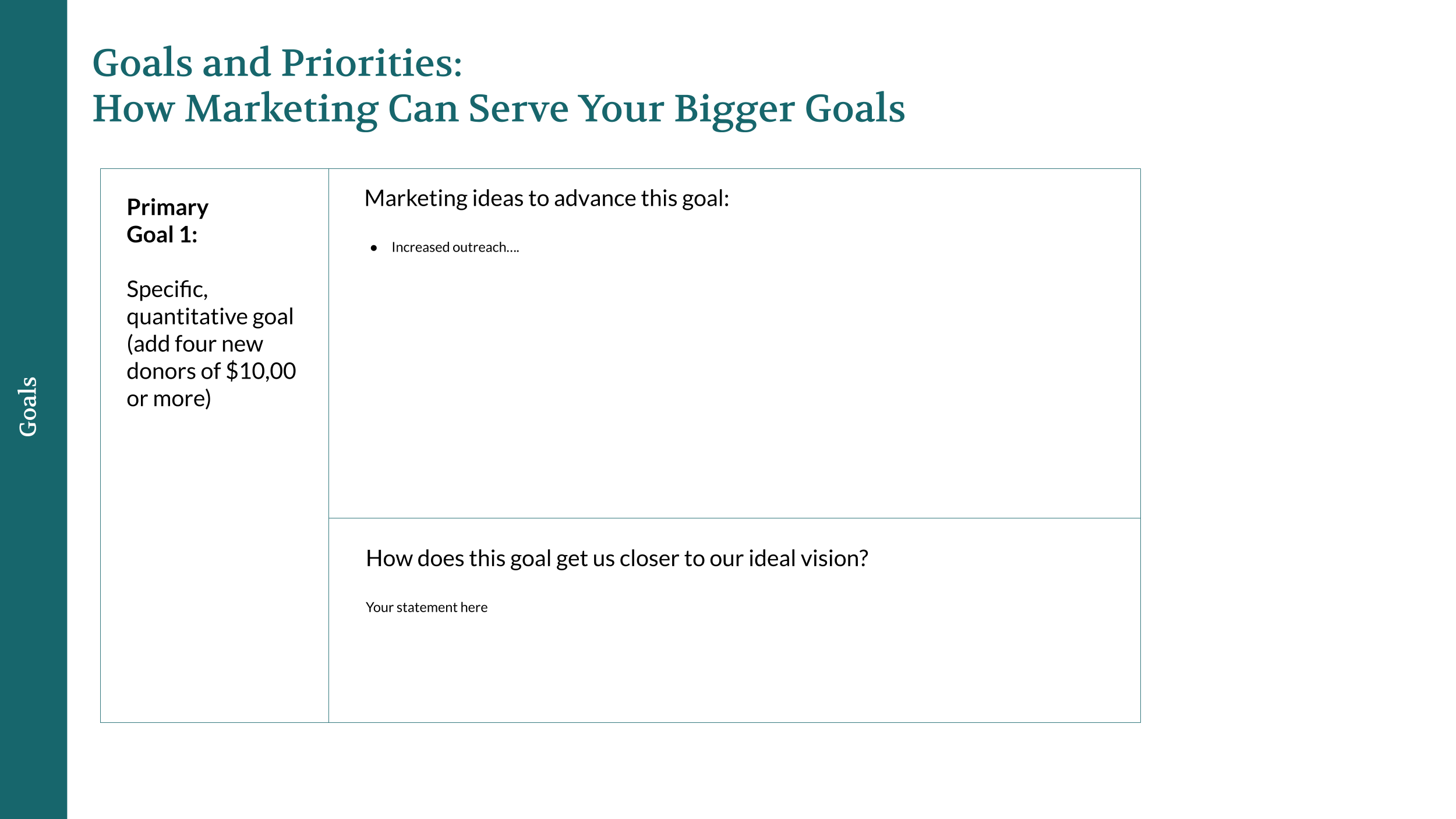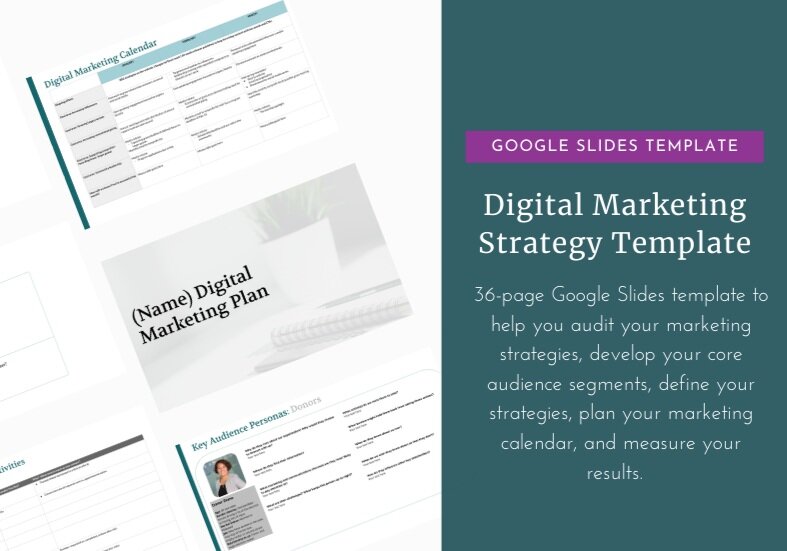What should your nonprofit digital marketing strategy include? The 7 sections every nonprofit marketing plan should cover (with a template to help)
What should a digital marketing strategy include? Does my nonprofit even need a digital marketing plan? You're in the right place if you’ve found yourself asking those questions.
For years, nonprofits have taken a back seat to marketing strategies that are working for businesses every day because they aren’t sure if they are supposed to market themselves or if it’s okay to use strategic tactics to reach more people. Nothing could be further from the truth!
Nonprofits deserve to use every tool available to spread their message far and wide. From going all in on content marketing to partnering with corporate sponsors and hosting webinars, there’s nothing that’s “off the table” for nonprofits.
The problem? It’s daunting, and if you know anything about the nonprofit world, then you know the people who run them wear more hats than I have space to list here. By the time it comes to putting together a digital marketing strategy, there’s little energy left to do anything “by the book,” and the process looks a whole lot more like winging it.
Unfortunately, without a road map, clear goals, and a plan to measure the results, many nonprofits will spin their wheels trying everything from spirit nights to raffles and miss the opportunity to create a real plan that actually takes less work in the long run.
So, what should a digital marketing strategy for nonprofits include? Let’s take a look at the seven sections I recommend including.
Your mission and vision statements
Any plan for your nonprofit should begin by reminding yourself (and those using the plan) of your own mission and vision. By stating this right upfront, you’re giving yourself a mechanism to decide if everything else that follows aligns with those statements.
A complete audit/recap of the previous year’s strategy
I know the temptation that comes from creating a bright, shiny, new plan. You want to get right to all the things you’ll do and create. However, by skipping straight to what’s next, you’re forgetting to evaluate what you’ve already tried. Why incorporate seven new press releases if the last five haven’t given you the results you wanted? When you recap what you’ve already tried and use real data to assess its impact, you’re able to more clearly define what might work in the future.
First, make a list of all the marketing activities you used in the prior year, mark them as successful or unsuccessful, and then add a short statement of what metrics you used to make that conclusion.
For example, let’s say you tried hosting webinars for the first time. Make a list of all of your webinars, the attendance for each, the conversion rate for any calls-to-action, and the software you used. Not only will you want to evaluate the impact of that time (prep and presentation) but you’ll want your audit to help you identify the best webinar platforms to help you reach your larger goals in the future.
Next, do a full audit of your website performance. This should include categories like website traffic, referral sources, the most popular pages, and the results of any calls-to-action (i.e. how many clicks on that donate button and what percentage actually made a gift).
If you have a consistent email marketing plan, evaluate the most engaging emails (ones where people took action) and draw some conclusions about why those emails resonated with your audience.
Last, do an audit of your social media presence, noting which platforms have the most engagement and which are leading to real results (donors, volunteers, etc.)
Key Stakeholder personas
Don’t let those marketing terms scare you away! This just means that in order to plan your marketing activities, you have to know who you want those activities to attract. Most nonprofits have a few basic audiences — donors, volunteers, clients, and potential board members. Take some time to explore each audience and better understand them by exploring questions like why do they care about us, where do they get their information, what do they expect from us, and what actions do we want them to take?
Goals and priorities
Another big mistake nonprofits make when planning their marketing is to skip over listing the bigger goals and priorities first. Before you decide how many events to have, you’ll first need to know the goal of those events. Try to set no more than 4-6 primary goals. Try to set no more than 4-6 primary goals - you can use data from a good ai marketing company to help you with this. For each goal, list the marketing activities that might get you closer to that goal and then how that goal gets you closer to your ideal vision (remember, that’s why we started with a mission and vision statement).
Here are some example goals:
Add four new donors of $10,000 or more
Grow our planned giving donors by 25%
Retain 80% of our donors from last year
Key Messages
Once you do decide on which marketing tactics you’ll focus on, it can become overwhelming to create new content for all the marketing channels. Instead, define your key messages for each of the audiences you have ahead of time. For each audience, define the ultimate action you want them to take and then create a core message that will be communicated in everything you publish for that audience.
Marketing Tactics and Calendar
Now you’re finally ready to get specific. For each goal area, choose one marketing tactic that will be ongoing and then add additional tactics for each month.
For example, you might have a Google Ad Grant that you’re running all year long. But, in January and February, your marketing focus is on recruiting board members, in the spring you’re working to engage your major donors, and in the fall, your efforts are on maximizing volunteer hours.
As with any plan, it’s subject to change but by laying it out in this format, you can easily swap out ideas, add new ones, or move activities to a new month.
Measurement tools
The worst thing you can do is spend all that time creating a master marketing plan and then forget to measure how it’s working. For each goal you created, decide on a measurable target performance indicator and how often you’ll measure the results.
While this method might appear daunting to some, it doesn’t have to be. The most important thing to remember is that every marketing activity you choose should ultimately be tied back to your organization’s vision. Try not to get consumed with “doing all the things” and instead, focus on doing the things that can be evaluated it measured. One last note here — don’t get too hung up on the format of your plan. This can easily be created in a Google Doc, Microsoft Word, or something like Microsoft PowerPoint or Google Slides.
If you’d like to save time on the format and just focus on creating your plan, I have a template for you!
Get the template - 36 customizable slides
This template includes:
36 customizable slides designed in Google Slides to guide you through the digital marketing strategy process.
Designed in six sections, the strategy helps you audit and plan all in one place. Sections include audits, audience, goals & priorities, core messaging, marketing calendar, and measurement systems.
Google Slides can easily be shared with your board members, staff, or other key stakeholders for easy input and collaboration.
Some example data has been included to help you brainstorm and get the ideas flowing!
If you have questions about creating your marketing plan or a tip others should consider, leave a comment below!
Until next time,
Andrea
One Nine Design is a digital marketing company helping small businesses and nonprofits learn how to use their website and email list to grow their reach and make a bigger impact!
Like this post? You might find these posts helpful, too!










